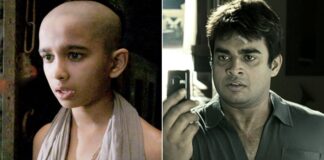From Prada To Nada is about two sisters, Camilla Belle and Alexa Vega, who are left penniless after the sudden death of their father. The siblings are forced to move in with their estranged aunt, Adriana Barraza, in East Los Angeles. Read the review to find out more.
Business rating: 1 star
Star cast: Camilla Belle, Alexa Vega, Adriana Barraza, Nicholas D’Agosto.
What’s Good: Certain elements of the screenplay, which will appeal to the teenage girls in the audience.
What’s Bad: The weak screenplay; the caricaturized characters; the absence of humour and emotions.
Verdict: From Prada To Nada is strictly average fare; which will reflect on its box-office performance in India.
Loo break: Several. When you realise that the story is going nowhere.
Watch or Not? Watch only if you like chick-flicks.

Gilbert Films, Lionsgate and Odd Lot Entertainment’s From Prada To Nada is a romantic-comedy about two sisters, who fall from riches to poverty, and have to adjust to their new circumstances.
Two sisters, Nora (Camilla Belle), a law student, and Mary (Alexa Vega), an undergrad party girl, are living with their father in a luxurious mansion in Beverly Hills, Los Angeles. Their mother had passed away when they were very young and since then, their father has spoilt them with all his riches. As a result, Mary is quite a spoilt child as she splurges all her money on fashionable clothes and accessories. Nora, however, is serious about her studies and plans to become a lawyer soon. However, the sisters’ lives take a drastic turn when their father dies. As they are mourning his death, they discover that he was bankrupt. On top of that, they also discover that he has a son from an earlier affair, who now buys off their father’s Californian mansion for a pittance. Their step brother, Rodrigo (Kuno Becker) moves in with his wife, Olivia (April Bowlby), who starts remodeling the house before she can put it up for resale. At Rodrigo’s insistence, Olivia lets the sisters stay on in their house for a while. Olivia’s lawyer brother, Edward (Nicholas D’Agosto), comes calling for lunch. Soon, Olivia mocks the sisters and Nora decides to leave the place immediately.
Having no other option, the sisters end up going to the other side of town, East LA, which is full of Latinos. They take refuge in their maternal aunt, Aurelia’s (Adriana Barraza), modest but lively home in the neighborhood. The house is full of ladies of all shapes and sizes, who do stitching jobs for a living. Nora quickly adjusts to their new life of simple living, but Mary is at her wits end. She is ashamed of her situation and her Mexican roots. Being used to all the comforts and luxury, she doesn’t know what to do other than seek refuge in the arms of the first charming and rich man she comes across. Nora, on the other hand, finds employment as a law assistant, when Edward hires her. There is also one Bruno (Wilmer Valderrama), a neighbour, who helps around the house, and soon falls in love with Mary.

Bit by bit, the sisters adapt to their new environment; their swanky cars are traded for the public bus and a used car. Nora receives a proposal from Edward which she rejects. She also leaves her job. Mary, who is by now, deeply in love with Rodrigo, realises that he is a married man. What happens next? Do the sisters find their place in the world? Are they able to forget their dad’s untimely death and get on with life? What about their love-lives? The rest of the film and the climax reveal the rest.
Story and Screenplay – From Prada To Nada Review
Fina Torres, Luis Alfaro and Craig Fernandez’ screenplay, which is a loose adaptation of Jane Austen’s novel, Sense and Sensibility, includes all the element of a typical Hollywood rom-com, but the writers fail to exploit the potential of the story. We all, more or less, know the story, and how it will end. The screenplay fails in arousing any interest whatsoever in the audience because it repeats the tried and tested formulae. Girls, who fall upon hard times, take refuge in new male partners that they encounter. The humour in the dialogues is non-existent and so is the drama. The supposed tragedy, that befalls the sisters, after their father’s death, turns out to be no tragedy at all. The girls shed a few crocodile tears and move on. Mary, whose character is a caricature of a spoilt brat, is not concerned about anything else, but getting her monies back somehow. However, as soon as her heart is broken, she conveniently moves on to the next guy. Nora, on the other hand, is just plain confused about her feelings for Edward, and refuses his advances, only to go back to his desperately (for some reason that is not clear to the audiences) at the last moment, right before his wedding. Had the writers done a better job at adding some romance to the script, these very parts, which stand out as illogical, might have made for a good watch. Only the film’s climax has a few scenes that will appeal to a few, especially teenage girls.

Star Performances – From Prada To Nada Review
The actors’ performances are average. Camilla Belle looks innocent but is a misfit in her role. She overacts in a scene where she is supposed to be drunk. Alexa Vega looks old in comparison to her sister, although she is supposed to be the younger one. Even she delivers an uninspiring performance. Adriana Barraza is good as the girls’ aunt but has limited scope. Nicholas D’Agosto is cute and acts well. Wilmer Valderrama, Kuno Becker and April Bowlby do average jobs.
Direction, Music and Editing – From Prada To Nada Review
Angel Gracia’s direction is nothing to write home about, as the film never rises above its average script. Heitor Pereira’s background score is okay. Héctor Ortega’s cinematography is eye pleasing. The Latino neighbourhood springs to life in his bright and colourful frames. Brad McLaughlin’s editing leaves much to be desired.
The Last Word
All in all, From Prada To Nada is uninspiring fare. Due to its average script and its poor promotions, it will prove a ‘Nada’ (zero) at the Indian box-office.



 Follow Us
Follow Us









